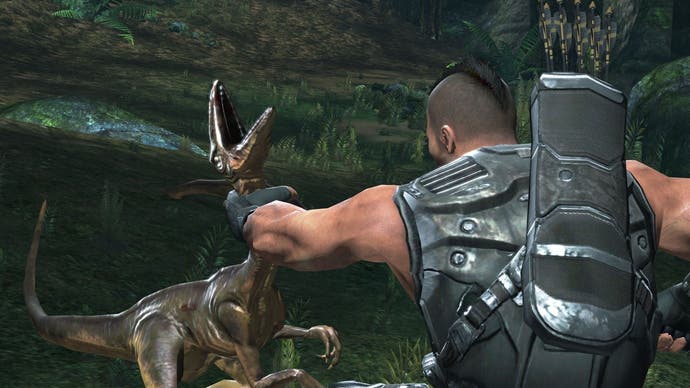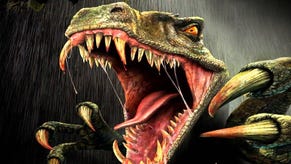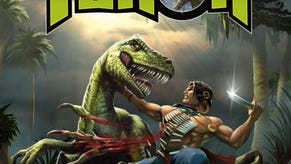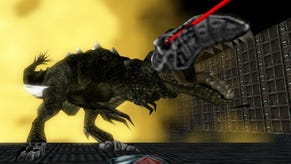Turok
Fossil refuelled.
You can tell a lot about a game by its subtitle. Take the Turok series of dinosaur-themed shooters, inspired by the adventure comics of the same name. First there was Dinosaur Hunter: blunt, functional, dynamic and serious. It told you everything you needed to know about this punchy, atmospheric jungle FPS, a Nintendo 64 launch title. Then came Seeds of Evil and Shadow of Oblivion: epic, suggestive, but ultimately insubstantial. They sounded exciting but dissolved into nothing more than meaningless internal rhymes if you thought about them too hard, just as the two sequels lost their way in a maelstrom of nonsensical plotting and overwrought gore.
And then there was Evolution: self-conscious, attention-seeking, desperate to sound new but unwilling to cut ties with the past, and frankly - when stuck under a picture of a dinosaur on the box - a bit of a cruel irony. So it was with this messy and abortive attempt to bring Turok to a new, multi-format generation. After that and many other sizeable failures, parent company Acclaim went bust, and Touchstone Studios (the adult label of Disney Interactive) picked up the rights to Turok.
Hence this rebirth for the series, due in February next year. It has no subtitle at all: clearly a cool customer, a back-to-basics fresh start, a strong and silent type. 'Other games? What other games?' is the message. "We were looking for a property that had a lot of creative flexibility," says lead designer Devon Blanchet of Disney-owned developers Propaganda Games, diplomatically. "A blank slate was the best way. It removed any questions of relaying it back to the old properties, for one thing." Which, given the critical and commercial mauling given to Evolution, Propaganda was understandably quite keen to do.

So we get an all-new Turok - the none-too-enigmatically named Joseph Turok, who is, get this, some kind of black ops special forces space marine with a dark past - an all-new storyline, and an all-new setting: an alien planet in the relatively near future. It's not all novelty for the sake of it, however. Blanchet says the Propaganda team are big fans of the 1997 original, and were partly motivated by a desire to get back to the essence of the character, and the core of the game. So Turok is a Native American; he uses a bow and arrow alongside more high-tech (but not completely far-fetched) weaponry; the surface of the planet is a dense jungle. "You definitely have to be careful," Blanchet says. "We have a Turok bible for that specific reason. Here are the guidelines for the world, the character, the creatures, here are the things you can and can't do."
And the one thing you can and must do in Turok is kill dinosaurs. Many of the alien planet's creatures are therefore strangely familiar from Earth's Mesozoic period - but some aren't. Alongside the expected raptors and T-rexes - mostly starving and mutilated, with something of the zombie about them - we meet species of Propaganda's own devising, like the 'lurkers'. Conceived as a cross between a komodo dragon and a jungle cat, these agile and stealthy low-slung lizards strike quickly from long grass and tree tops. Dinosaur attacks jump the camera out to third-person as Turok fights off their mauling with a spot of quick trigger-hammering or stick-waggling. These sequences have a real visceral punch, aided by the simple but effective 'red mist' effect that lets you know when your recharging health is down - one of many things about this game reminiscent of Ubisoft's excellent King Kong.

Unlike Skull Island, though, this particular prehistoric jungle is infested with enemy soldiers as well as angry lizards. These troops are in the employ of Turok's former mentor and current nemesis, Roland Kane, and they sport the latest in Killzone-inspired space-Nazi chic: black biker helmets and eye sockets that glow with pure evil (and make headshots easier). Turok has brothers in arms too, the gruff and argumentative Whiskey Company, who all seem to think they're in Predator (and aren't all that far wrong). There are no squad commands; they serve purely as story focus, buddy AI and a handy distraction for the dinos. Enemy soldiers come under attack from the wildlife as well, and one of the game's more intriguing aspects is the ability to use flares to direct the dinosaur's attention towards the opposition.
There are signs of a solid, flexible and creative tactical range in Turok's armoury. Items like the sticky bomb gun, auto-turret and explosive arrowheads serve up some entertaining carnage options, and every weapon has a secondary fire - just as well since you can only carry a couple of guns (not counting dual-wield) and a bow at one time. But the key weapon, if anything, is the knife: used with good timing, it performs silent and gruesome kills, which like dino-wrestling, ladder-climbing and the like is shown in third-person. It's a Halo-style instant melee kill combined with a replacement for the earlier games' more OTT death-dealers, such as the cerebral bore. "The knife's where we fill that gap," says Blanchet. "People who are really into a visceral way to kill something have an opportunity, but we pay it off better. It's more satisfying visually, it's got a great risk and reward component to it."

Knife kills are especially satisfying in the game's 16-player multiplayer mode: both players get the third-person kill animation, which is glorious for the knifer and humiliating for the knifee. But the matches we've played quickly degenerate into conga-lines of players trying to sneak up and knife the guy in front, so much more effective is the blade than the guns. The maps look dramatic, and the inclusion of AI-controlled dinosaurs on all but one of them adds welcome unpredictability and death-trap tension. However, they seem too large, unstructured and unfocused to provide satisfying tactical matches for any less than the maximum number of players.
A hands-on session with the single-player campaign indicates a workmanlike, polished and pacey sci-fi actioner that doesn't manage to bust out of cliché, but does just enough to distinguish itself in its weapon set and tense, hunt-or-be-hunted atmosphere. Fending off dinosaurs is panicky and fast-paced, and currently a fair bit more compelling than the extremely conventional fire fights with enemy soldiers; it's where the two meet that Turok has the potential to offer something interesting, and a lot will depend on how well Propaganda manages to stage-manage these three-way battles.
Although the game's jungle and creatures look right - a little samey and not quite convincingly natural, but right - we worry that the heavy focus on teams of hard-bitten men-mountains shooting each other had left too much of what makes Turok different behind in the rush to stand so close genre darlings like Gears of War. Or rather, we would worry about that if there were any die-hard Turok fans left in the world. As it is, this is the franchise with nothing to lose and everything to gain - as Touchstone well understood when they bought it - and currently Propaganda can't help but make things better. They just need to watch what they do with that subtitle next time.








.png?width=291&height=164&fit=crop&quality=80&format=jpg&auto=webp)




.jpg?width=291&height=164&fit=crop&quality=80&format=jpg&auto=webp)
